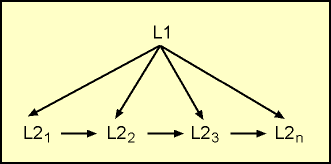The case for grammar
The process of acquisition involves making modifications to the learner's interlanguage (Selinker, 1972) where interlanguage is a developing system that is intermediary between the L1 and the L2, with grammar rules that may be a mixture of L1 and L2 rules, or may be rules that the learner him/herself has created. A learner will have a number of different interlanguages as proficiency increases (see Figure 3.2).

Figure 3.2: the development of interlanguages
Research now suggests that a focus on grammatical form is beneficial for interlanguage development (Doughty and Williams, 1998a; N. Ellis, 1993; R. Ellis, 1994, 2001; Fotos, 1993; Long, 1991; Long and Robinson, 1998), but there is much discussion as to whether this should involve a focus on lists of structure, or simply a focus on form as it appears in student output (see Willis, 1996; Willis and Willis, 2001).
Larsen-Freeman and Long maintain that:
Formal SL instruction does not seem able to alter acquisition sequences... [but has] clearly positive effects on the rate at which learners acquire the language, and probably beneficial effects on their ultimate level of attainment. (Larsen-Freeman and Long, 1991: 321)
Skehan believes that 'methods of contriving a focus on form are needed which capture learners' attention, so that they may incorporate newly noticed forms into their developing language systems' (Skehan, 1998: 4). Schmidt and Frota (1986) suggest that reliance on communication strategies alone does not lead to improved syntactic accuracy. Pienemann (1988) argues that instruction does not alter the order of acquisition, but it does accelerate it. Gass finds that '[p]edagogical descriptions may aid the learner to internalize parts of the target language' (Gass, 1997: 154) and that '[f]ocused instruction […] is a first step in the modification of one's grammar" (Gass, 1997: 155).
Ellis states that 'it seems reasonable to assume that formal instruction is of value in promoting rapid and higher levels of acquisition' (Ellis, 1990: 133), that naturalistic learners 'do not develop high levels of accuracy even though they become communicatively effective' and that 'instructed learners do better than naturalistic learners precisely because they are encouraged to focus on form' (Ellis, 1990: 165). Hulstijn and Hulstijn (1984) also found that learners who were asked to pay attention to form improved the correctness of their utterances.
There has been growing interest in recent years in the contribution of cognitive psychology to L2 learning theory, and many believe form-focused instruction provides the sort of practice necessary for automatization of language forms (see, for example, McLaughlin, 1987; Johnson, 1996, DeKeyser, 1998).
Other findings demonstrating that grammar teaching has a positive influence on the learning/acquisition process, include the following:
- Form-focused teaching makes grammar more salient or noticeable (eg Schmidt, 1990, 1995; Schmidt and Frota, 1986), and noticing, at some level, seems essential for acquisition.
- Post-puberty L2 learners seem to need an element of analysis in their learning (DeKeyser, 2000).
- Explicit form-focused instruction seems to compensate for a lack of analytical aptitude in learners (Robinson, 1995).
- Grammar forms which are easy to comprehend but difficult to produce (eg Spanish conditional forms, French reflexives) may benefit from a form- and output-focused approach; forms which are difficult to comprehend (especially in relation to L1) but easy to produce (eg Spanish OVS word order) may benefit from a more input-oriented approach, though still form-focused (see DeKeyser and Sokalski, 1996; VanPatten and Cadierno, 1993; VanPatten and Sanz, 1995).
In general, then, the research consensus is that grammar is seen to aid the acquisition process, while grammarless instruction leads to fossilization, ie the language system does not continue to develop (Skehan, 1998).
There are also communicative arguments in favours of a focus on grammar rules: 'Grammar […] is a description of the regularities in a language, and knowledge of these regularities provides the learner with the means to generate a potentially enormous number of original sentences' (Thornbury, 1999: 15). And indeed, there are clear pragmatic arguments for teaching grammar in classrooms. As Turner points out, '[i]n foreign language learning, grammatical knowledge must be explicitly taught for there is simply not enough contact time to pick up its patterns and regularities in passing' (Turner, 2002: 67).
In terms of pedagogy, while we have noted that there are problems with the use of simplified rules, simplification may also bring benefits. Nation, for example, notes that:
Simplification is an important tool in second language learning. It may be that the use of the term with its implications of reducing text is unsuitable and something like 'roughly tuned input' will get simplification the respectability it deserves. Without simplification, the strands of meaning-focused input, meaning-focused output, and fluency development become impossible for all except advanced learners […] Many of the criticisms of simplification are criticisms of bad simplification. We need to have standards of good simplification and praise those texts that exemplify them. (Nation, 2001: 172-73)
Van Els et al suggest that:
[...] it is sometimes forgotten that communicative competence not only includes a command of rules of language use, but also a command of morpho-syntactic rules, and that in the absence of some form of grammatical gradation there is no guarantee that the latter will be attained. (van Els et al, 1984: 230)
Indeed, in a survey of modification in teacher speech to non-natives, Chaudron (1988) shows clearly that teachers simplify their own language output in terms of syntax, lexis, and rate of speech, and that the degree of simplification relates directly to the proficiency of the learners. In other words, not only do textbooks take a graded approach to grammar in the syllabus, but teachers seem to unconsciously follow this tendency.
Cook (2001: 225) adds that 'simplified grammar, slow clear speech, and the selection of basic vocabulary, are natural features of adult speech to children, and […] to a foreign speaker of our language'.